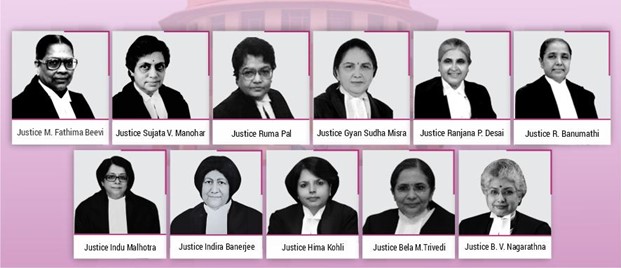The exemplary eleven

After 76 years of independence, higher judiciary in India epitomizes a prejudicial picture as regards the women representation in the benches. Historically, women representation in the judiciary was extremely low. Women were not encouraged enough to build up a career in law. Those who have taken up the career have faced significant discrimination and challenges. In 1892, Cornelia Sorabji was the first woman to be admitted into the legal profession. Despite her efforts, she could not continue her profession in law under British India. Though the Legal Practitioners (women) Act, 1923 has exposed a changed scenario for women lawyers, practicing law among women remained as a barrier in India.
A diverse judiciary is the necessity of the time which can produce different perspectives and voices within the courtroom. The diverse features within the legal system do possess certain positive elements for strengthening the judiciary by eliminating the unconscious bias and stereotyping. A democratic society calls for an equal representation of both men and women. But this has been diluted with the complex method of judicial appointments in India. The impact of female representation was a much debated issue of recent times which mainly advocates for gender inclusivity in judiciary.
For the first 39 years of the judiciary, there were only male judges. The woman who opened the closed door and broke the glass ceiling in judiciary is Justice Fatima Beevi, who was appointed as the first woman judge of the Supreme Court of India in 1989. She made history by becoming the first Muslim woman and first female judge in Asia. As a tribute to the eminent judge, a documentary titled, “A brave woman in the path of Justice” was screened at Thiruvananthapuram in 2023, which unfolds the journey that made her to the apex court.
The discourse on women who have risen to bench in spite of the hurdles seems incomplete without mentioning Justice Indu Malhotra, who was the first woman who was elevated to SC directly from Bar in 2018. Her noteworthy judgments include the Sabarimala temple entry case, decriminalizing same sex relations, striking down 497 IPC etc.
STATISTICS
As per the data released by India Justice Report, 2022, only 33% of total number of judges in district level is women and at higher court level, it is 13%. It shows the disparity in the appointment of women judges in India. Though smaller in area, Goa accounts the highest number regarding the appointment of women judges with 70%. IJR states that recently there is an escalation in the appointment of female judges in subordinate courts than the district courts.
BARRIERS
There exist certain structural barriers that hinder the diverse judiciary in India. The patriarchal influence and the male dominant society are having the potential to affect the equal representation in Judiciary. Gender stereotyping, harassment, and discrimination, insufficient infrastructure and institutional support are the other prominent factors that impede the appointments that call for the inclusivity in the Indian legal system. Additionally, the class, caste, religious affinity, sexuality add on to the oppression of the female gender to assume responsibility in the legal system. Opaque system of collegium also renders it impossible to get through to the judiciary in par with their male peers.
Since the formation of the higher judiciary, there have been 11 female judges who have decorated the seat so far. After Fathima Beevi, the only woman who has been appointed in between 1990 and 2000 is Justice Sujatha V Manohar who was succeeded by Justice Ruma Pal in 2000. The year 2010 can be earmarked with the appointment of 5 female judges including Justices Gyan Sudha Misra, Ranjana Prakash Desai, R. Banumathi, Indu Malhotra and Indira Banerjee. In 2021 the appointment of Justices Hima Kohli, B.V. Nagarathna and B.M. Trivedi made history as the most number of women appointed in one go. This far SC hasn’t had a woman Chief Justice.
To conclude so as to ensure an equal participation to acknowledge a diverse judiciary, the prejudicial practices, social norms and gender stereotyping should be eliminated. The appointment criteria should be more transparent and objective than being gendered. The intersectional barriers that impede the progress of marginalized women should be properly addressed. Developmental policies can be called forth and the governments should take actions to create infrastructure which can ensure equal opportunity that the dividing line becomes blurred one day.
REFERENCE:
Gita Mittal and dipika Jain, Women’s equal representation in the higher judiciary: a case for judicial diversity in India, Published online: 21 Jan 2023, https://www.tandfonline.com/
Uday Shankar and srichetha chowdhury, Representative Judiciary in India: An Argument for Gender Diversity in the Appointment of Judges in the Supreme Court, ILI law review vol. Ii
The impact of women in judiciary, Times of India, https://timesofindia.indiatimes.com/, 2023
Vipra Jain, Women in Indian judiciary, Indian Journal of Integrated Research in Law, Volume III, Issue III.
United Nations Office on Drugs and Crime. (2022). To achieve justice, we need more women in justice: The first International Day of Women Judges inaugurates a gender-responsive justice initiative. United Nations Office on Drugs and Crime.
Women of Indian Judiciary- Justice N.Fathima Beevi, Bar and Bench https://www.barandbench.com, Published: 12th Aug., 2023
‘I opened a closed door’ — Fathima Beevi, India’s 1st woman judge in SC who remains an enigma, https://theprint.in/, The Print, published on 8th March, 2022
J. Indu Malhotra’s 9 Most Significant Judgments, Supreme Court Observer, https://www.scobserver.in
